天文数据分析方法与计算
天文观测数据的模型拟合和分析方法
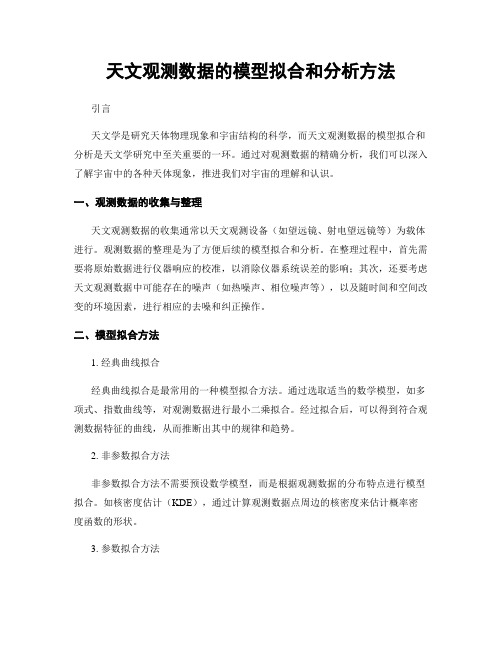
天文观测数据的模型拟合和分析方法引言天文学是研究天体物理现象和宇宙结构的科学,而天文观测数据的模型拟合和分析是天文学研究中至关重要的一环。
通过对观测数据的精确分析,我们可以深入了解宇宙中的各种天体现象,推进我们对宇宙的理解和认识。
一、观测数据的收集与整理天文观测数据的收集通常以天文观测设备(如望远镜、射电望远镜等)为载体进行。
观测数据的整理是为了方便后续的模型拟合和分析。
在整理过程中,首先需要将原始数据进行仪器响应的校准,以消除仪器系统误差的影响;其次,还要考虑天文观测数据中可能存在的噪声(如热噪声、相位噪声等),以及随时间和空间改变的环境因素,进行相应的去噪和纠正操作。
二、模型拟合方法1. 经典曲线拟合经典曲线拟合是最常用的一种模型拟合方法。
通过选取适当的数学模型,如多项式、指数曲线等,对观测数据进行最小二乘拟合。
经过拟合后,可以得到符合观测数据特征的曲线,从而推断出其中的规律和趋势。
2. 非参数拟合方法非参数拟合方法不需要预设数学模型,而是根据观测数据的分布特点进行模型拟合。
如核密度估计(KDE),通过计算观测数据点周边的核密度来估计概率密度函数的形状。
3. 参数拟合方法参数拟合方法则需要通过已知的数学模型来进行拟合。
常见的参数拟合方法有最大似然估计、贝叶斯统计方法等。
这些方法可以通过拟合参数的最优值来优化模型,提高拟合的准确性和可靠性。
三、模型拟合的准确性评估与分析模型拟合的准确性评估是分析结果可靠性的重要环节。
常用的评估方法有残差分析和拟合优度检验。
残差分析通过计算模型预测值与实际观测数据之间的差异,来评估模型的准确性。
而拟合优度检验则是通过计算模型拟合平均残差与原始数据的差异,来评估拟合效果。
这些评估指标能够帮助我们判断模型拟合是否符合实际观测数据的特征,并为进一步分析提供依据。
四、分析方法在模型拟合的基础上,我们可以通过分析模型参数、函数关系及其物理意义等方法,来深入理解天文观测数据背后的物理过程与规律。
天文学实验中的天体运动观测和数据分析方法

天文学实验中的天体运动观测和数据分析方法天文学是一门古老而神秘的科学,它研究的是宇宙中的天体运动和宇宙的起源。
在天文学的研究中,观测和数据分析是不可或缺的环节。
本文将介绍一些天文学实验中常用的天体运动观测方法和数据分析技术。
一、天体运动观测方法1. 光学观测:光学观测是天文学中最常用的观测方法之一。
通过望远镜观测天体的亮度、位置和颜色等信息,可以研究天体的运动规律和性质。
光学观测可以分为直接观测和间接观测两种方式。
直接观测是指直接观察天体的光信号,如通过望远镜观测恒星的亮度变化。
间接观测是通过观测天体对光的影响来推断其性质,如通过测量行星对恒星光的微弱偏移来确定行星的质量和轨道。
2. 射电观测:射电观测是利用射电波段的电磁波来观测天体。
射电观测可以穿透大气层,对于宇宙中的冷物质和弱信号的观测具有独特的优势。
射电观测可以研究宇宙中的星系、星云和脉冲星等天体,揭示宇宙的演化历史和结构。
3. 微波观测:微波观测是利用微波波段的电磁波来观测天体。
微波观测可以研究宇宙背景辐射、宇宙微波背景辐射等重要现象,对于研究宇宙的起源和演化具有重要意义。
二、数据分析方法1. 图像处理:在观测天体时,我们通常会得到一系列的图像数据。
图像处理是将原始图像数据进行处理和分析,提取出有用的信息。
常用的图像处理技术包括图像增强、图像滤波、图像分割等。
通过图像处理,我们可以清晰地看到天体的细节,进一步研究其运动规律和性质。
2. 数据建模:天文学实验中所得到的观测数据通常是复杂的,需要进行建模和拟合来得到更准确的结果。
数据建模是将观测数据与理论模型进行比较,通过拟合参数来得到最佳的模型结果。
常用的数据建模方法包括最小二乘法、马尔可夫链蒙特卡洛方法等。
通过数据建模,我们可以推断天体的质量、距离和运动速度等重要参数。
3. 数据挖掘:数据挖掘是从大量的观测数据中发现隐藏的模式和关联规则。
在天文学实验中,数据挖掘可以帮助我们发现新的天体、新的天体运动规律和宇宙结构。
天文光谱数据的特征提取与分析

天文光谱数据的特征提取与分析引言天文学家通过观测天体的光谱数据,可以获取关于宇宙中不同物质的组成、温度、速度和运动等重要信息。
然而,由于天文光谱数据的庞大和复杂性,如何从中提取出有用的特征并进行有效的分析成为一个挑战。
本文旨在探讨天文光谱数据的特征提取与分析方法,以期对天文学研究有所助益。
一、光谱数据的基本特征光谱数据是通过对天体辐射进行分光仪观测得到的,通常以图像或曲线的形式表示。
光谱数据可以分为连续谱和离散谱两类。
连续谱是由连续的辐射强度组成,代表天体的热辐射特征;离散谱则是由一系列谱线组成,代表物质的特定元素和分子的辐射特征。
光谱数据的基本特征包括中心波长、峰值强度、辐射带宽、线宽等。
二、光谱数据的特征提取方法1. 傅里叶变换傅里叶变换是一种常用的信号处理技术,可以将时域信号转换为频域信号,并提取信号的频谱特征。
在天文学中,可以利用傅里叶变换将光谱数据转换为频谱图,从而观察到不同波长的成分对应的能量分布情况。
2. 主成分分析主成分分析是一种常用的统计分析方法,可以从多个变量中提取出最主要的特征。
在天文光谱数据分析中,可以利用主成分分析方法提取出代表光谱数据主要变化的成分,从而减少数据维度并去除噪声。
3. 小波分析小波分析是一种具有时间-频率局部性质的信号处理方法,可以在不同时间和频率尺度上对信号进行分析。
在天文学中,可以利用小波分析方法提取光谱数据的频带特征,揭示出不同频率成分对应的物质特征。
三、光谱数据的特征分析方法1. 相关性分析相关性分析可以用来研究光谱数据中不同特征之间的相互关系。
通过计算不同特征之间的相关系数,可以确定它们之间的线性或非线性关联程度,进而推断出不同物质之间的物理关系。
2. 聚类分析聚类分析是一种将数据分为不同组或簇的统计方法,可以帮助我们发现天文光谱数据中隐藏的模式。
通过分析光谱数据的相似性,可以将不同天体或光谱特征归为一类,从而揭示出物理和化学性质相似的天体之间的联系。
天文数据处理方法

天文数据处理方法天文数据处理是天文学的重要分支,其主要目的是从天文观测数据中提取并分析有关天体的信息,以便更好地了解天体的特性和演化。
天文数据处理方法包括数据获取、数据清理、数据校准、数据筛选、数据分析等步骤,下面将详细介绍各个步骤的方法和技巧。
一、数据获取1. 观测记录法:通过天文望远镜、探测器等设备的观测记录获取原始数据。
2. 数字文件下载法:通过网络等渠道下载相关天文观测数据文件。
3. 个人记录法:天文学家自己进行的观测记录和文献资料。
在获取数据时需要注意数据的来源、格式、质量等方面的问题,及时对数据进行备份和整理,便于后续的数据处理和分析。
二、数据清理在得到原始数据后,需要进行数据清理,从中去除不合理的数据和噪声,以获取更可靠的结果。
数据清理的方法如下:1. 异常值检测:通过检查数据中是否存在异常值来筛选掉不合理的数据。
2. 噪声滤除:通过信噪比等技术滤除数据中的噪声,提高数据的可靠性。
3. 重复数据去除:去除重复的数据,避免对后续分析造成影响。
4. 缺失数据填补:对于缺失的数据,可以通过差值法或插值法等方法进行填补。
三、数据校准数据校准是为了保证数据的精度和准确性,对数据进行校准可以消除一些系统误差和仪器偏差。
数据校准的方法如下:1. 零点校准:通过调节仪器的零点来消除系统误差。
2. 线性校准:对于存在线性误差的数据,通过对数据进行线性拟合来消除误差。
3. 背景校准:对于存在背景噪声的数据,需要进行背景减法。
四、数据筛选数据筛选是为了滤掉不需要的数据和不合理的数据,从而得到更加精确和合理的数据。
数据筛选的方法如下:1. 范围筛选:根据数据的范围,筛选出符合条件的数据。
3. 精度筛选:针对需要高精度数据的应用,通过对数据进行提高精度的处理来筛选出满足需求的数据。
五、数据分析数据处理完成后,需要进行数据分析,以便对数据进行更加深入和全面的了解。
数据分析的方法如下:1. 基本统计分析:通过对数据的平均值、标准差、方差等基本统计参数的计算和分析来了解数据的分布和特征。
天文学数据分析与处理
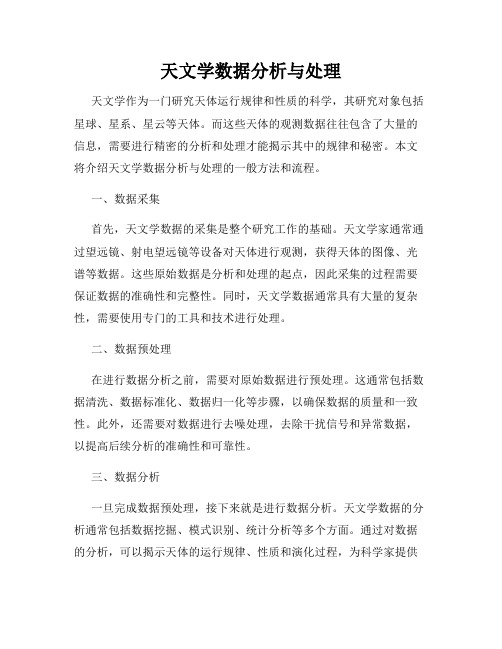
天文学数据分析与处理天文学作为一门研究天体运行规律和性质的科学,其研究对象包括星球、星系、星云等天体。
而这些天体的观测数据往往包含了大量的信息,需要进行精密的分析和处理才能揭示其中的规律和秘密。
本文将介绍天文学数据分析与处理的一般方法和流程。
一、数据采集首先,天文学数据的采集是整个研究工作的基础。
天文学家通常通过望远镜、射电望远镜等设备对天体进行观测,获得天体的图像、光谱等数据。
这些原始数据是分析和处理的起点,因此采集的过程需要保证数据的准确性和完整性。
同时,天文学数据通常具有大量的复杂性,需要使用专门的工具和技术进行处理。
二、数据预处理在进行数据分析之前,需要对原始数据进行预处理。
这通常包括数据清洗、数据标准化、数据归一化等步骤,以确保数据的质量和一致性。
此外,还需要对数据进行去噪处理,去除干扰信号和异常数据,以提高后续分析的准确性和可靠性。
三、数据分析一旦完成数据预处理,接下来就是进行数据分析。
天文学数据的分析通常包括数据挖掘、模式识别、统计分析等多个方面。
通过对数据的分析,可以揭示天体的运行规律、性质和演化过程,为科学家提供重要的研究线索和结论。
同时,数据分析也可以帮助天文学家发现新的现象和规律,推动天文学研究的进展。
四、数据可视化除了对数据进行分析,天文学家还需要将分析结果进行可视化展示。
数据可视化可以直观地展现数据的特征和规律,帮助研究人员更好地理解和解释数据。
常用的数据可视化工具包括散点图、柱状图、线图等,通过这些图表可以将复杂的数据信息以直观的形式展现出来。
五、数据存储与共享最后,天文学数据的存储和共享是整个研究过程中至关重要的一环。
天文学家需要将处理后的数据进行归档保存,以备日后研究和参考。
同时,天文学数据的共享也能促进学术交流和合作,推动天文学领域的发展和进步。
总结通过对天文学数据的分析和处理,科学家们可以揭开天体世界的神秘面纱,探索宇宙的奥秘和规律。
天文学数据分析与处理是一项复杂而重要的工作,需要科学家们的不懈努力和探索精神。
天文观测技术及数据分析研究

天文观测技术及数据分析研究天文学作为一门基础性科学,其研究注重探索宇宙本身的规律以及深度剖析物质和能量的本性。
而天文观测技术和数据分析则是支撑天文学发展和进步的基础保障。
随着科技的发展和进步,天文观测技术和数据分析水平达到了一个新的高度。
1. 天文观测技术天文观测技术是天文学研究的基础,其目的是收集宇宙中的物理信息和数据。
目前,天文观测技术主要有光学望远镜、射电望远镜以及空间望远镜等三种。
1.1 光学望远镜光学望远镜是天文观测技术的最主要执法工具之一。
通过光学望远镜,天文学家可以对各种天体进行观测,例如:太阳、恒星、行星、星云和星系等。
光学望远镜的原理是通过收集远离天体反射过来的光线,并聚焦到一个点上,在该点位上形成一幅具有物理含义的图像。
目前,光学望远镜的观测精度已经达到极高的水平,例如: 采用残差屏幕技术的细节测量仪、采用自适应光学技术的望远镜等,这些技术可以使光学望远镜的观测精度提高到亚弧秒级别。
1.2 射电望远镜射电望远镜是天文学研究中的另一个重要工具。
射电望远镜原理与光学望远镜相似,是通过收集天体反射过的微波信号,并聚集到一个点上,形成具有实际物理意义的图像。
射电望远镜主要用于探索宇宙背景辐射、银河系结构和活动星系核等天体的相关数据。
近年来,射电观测领域所采用的技术包括采用毫米波和厘米波的探测技术、通过采用窄带滤波功率谱估测技术提高观测精度等。
1.3 空间望远镜空间望远镜是指通过外太空进行天文观测的科技工具。
与地面上的天文观测卫星相比,空间望远镜可以更好地避免干扰,获得更完整、丰富的数据。
目前,著名的空间望远镜有哈勃太空望远镜(HST)、钱德拉X射线望远镜(Chandra)以及示波H瞬变探测器(Swift)等。
空间望远镜的数据分析技术也得到了很大的进步.2. 数据分析技术数据分析技术是现代天文学研究中的一个重要环节,它的主要功能是对观测到的数据进行仔细的检查、处理及分析。
天文学中的数据处理与普通科学领域的数据处理相比要困难一些。
天文学概念知识:天文学中的计算机模拟和数据处理

天文学概念知识:天文学中的计算机模拟和数据处理天文学是研究宇宙中各种天体之间相互作用、动态演化及宇宙结构与演化历史的科学。
通过计算机模拟和数据处理的手段,可以为天文学家提供更加精确的分析工具和研究手段,促进天文学研究的发展。
一、计算机模拟在天文学中的应用计算机模拟是通过数值计算方法对天文学问题进行模拟和模拟实验,以研究天体物理性质、宇宙结构和演化,以及撞击等事件的后果等。
计算机模拟还可以对理论做出预测,验证前人的理论,对未来的天文观测提供说明。
1.恒星演化模拟恒星是天文学中最常见的天体,也是最基本的天体之一。
通过计算机模拟,我们可以模拟恒星的演化历程,包括从星际物质到形成恒星,以及恒星生命周期的各个阶段。
这些模拟可以帮助天文学家对恒星的形成、演化和死亡进行研究,为我们更好地理解宇宙的进化提供了基础。
2.宇宙结构模拟通过计算机模拟,天文学家还可以模拟宇宙结构的演化,包括宇宙大尺度结构和黑暗物质分布。
这种模拟可以通过模拟初始条件和宇宙演化历程,还原出宇宙中大尺度结构的演化。
这对于研究宇宙学中的重大问题,例如宇宙的初始条件、宇宙中物质的丰度以及宇宙学常数等都有极为重要的意义。
3.行星受测量和轨道研究行星是近年来最热门的天文学研究领域之一。
对于行星的天体物理和动力学等问题,计算机模拟也能够提供非常准确的研究手段。
通过计算机模拟,我们可以分析行星的轨道变化和星系中的相互作用,特别是行星和恒星之间的相互作用,使得我们可以更好地了解行星的形成和演化历程。
二、数据处理在天文学中的应用数据处理也是天文学中的重要工具之一,用于处理天文观测数据,包括天体物理性质、空间分布特征等。
数据处理可以帮助天文学家对观测数据进行比较详细的分析,并检测出各种天文现象。
常用的天文数据处理方法包括信号处理、计算机视觉和机器学习等。
1.信号处理信号处理是天文学中的重要方法之一,主要涉及到天文信号的提取和分析。
天文信号是指来自宇宙中的电磁波信号,包括无线电波、红外线、紫外线和X射线等。
天文观测与数据分析:教案二

天文观测与数据分析:教案二天文观测是研究天空中各种现象和物体的观测,是天文学研究的基础。
天文观测包括望远镜的观测、光谱观测、射电观测等。
近年来,随着数据采集仪器和分析技术的不断提高,天文观测数据的处理分析变得更加重要,也更加复杂。
教学目标本节课让学生了解天文观测和数据分析的基本概念,掌握天文观测的基本方法和数据处理和分析方法。
教学内容一、天文观测概念天文观测是指测量和记录天文现象和物体。
天文观测包括用望远镜观测、频谱分析仪分析、望远镜收集的射电波分析等。
二、天文观测方法1、用望远镜观测在不同波段进行天文观测,例如肉眼可见光波段,射电波段等。
望远镜可以将光线聚集在一点上,并显著提高空间分辨率和灵敏度。
2、频谱分析仪分析通过分析光谱,可以得到物体的重要信息,例如物体的物理性质,温度,金属含量等。
3、望远镜收集射电波分析用射电望远镜观测,主要是观感察射电波段的活动,例如星际物质,黑洞,行星等。
三、天文观测数据处理与分析方法1、天文图像处理天文图像处理是将原始天文图像转化为更容易理解的图像,能够展示出天文对象中的精细结构,例如星系,行星,星云等。
2、光谱数据处理光谱数据处理是将从光谱仪收集的数据进行分析,从而推断出天体的特征和性质。
例如,测量温度、化学成分、放射强度等。
四、天文数据分析软件介绍1、PythonPython是一种高级编程语言,广泛应用于科学计算,包括天文领域。
Python的库和模块提供了用于数据处理和分析的工具,可以用于数据可视化和建模等。
2、IDLIDL是一种交互式数据处理语言,最早由斯密森尼天文物理研究所(SAO)开发。
IDL具有强大的矩阵操作和统计分析功能,同时也提供了可视化和图像处理接口。
总结天文观测与数据分析是天文学研究过程中不可或缺的一部分。
学生通过本节课的学习,能够了解天文观测和数据分析的基本概念,掌握天文观测的基本方法和数据处理和分析方法,从而对天文学的研究有个全面的了解。
天文观测数据处理与分析方法
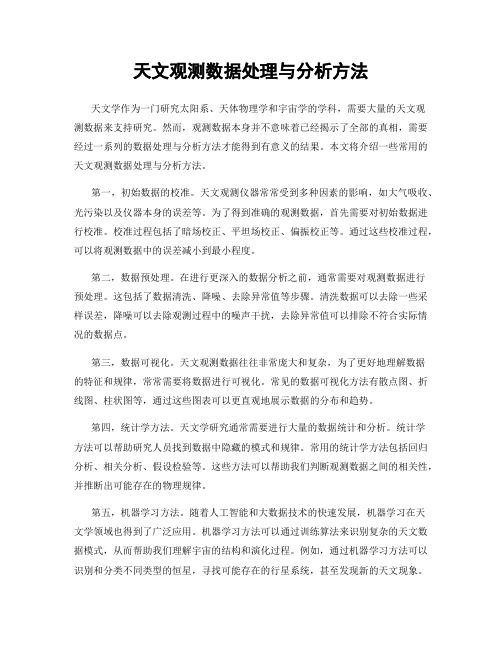
天文观测数据处理与分析方法天文学作为一门研究太阳系、天体物理学和宇宙学的学科,需要大量的天文观测数据来支持研究。
然而,观测数据本身并不意味着已经揭示了全部的真相,需要经过一系列的数据处理与分析方法才能得到有意义的结果。
本文将介绍一些常用的天文观测数据处理与分析方法。
第一,初始数据的校准。
天文观测仪器常常受到多种因素的影响,如大气吸收、光污染以及仪器本身的误差等。
为了得到准确的观测数据,首先需要对初始数据进行校准。
校准过程包括了暗场校正、平坦场校正、偏振校正等。
通过这些校准过程,可以将观测数据中的误差减小到最小程度。
第二,数据预处理。
在进行更深入的数据分析之前,通常需要对观测数据进行预处理。
这包括了数据清洗、降噪、去除异常值等步骤。
清洗数据可以去除一些采样误差,降噪可以去除观测过程中的噪声干扰,去除异常值可以排除不符合实际情况的数据点。
第三,数据可视化。
天文观测数据往往非常庞大和复杂,为了更好地理解数据的特征和规律,常常需要将数据进行可视化。
常见的数据可视化方法有散点图、折线图、柱状图等,通过这些图表可以更直观地展示数据的分布和趋势。
第四,统计学方法。
天文学研究通常需要进行大量的数据统计和分析。
统计学方法可以帮助研究人员找到数据中隐藏的模式和规律。
常用的统计学方法包括回归分析、相关分析、假设检验等。
这些方法可以帮助我们判断观测数据之间的相关性,并推断出可能存在的物理规律。
第五,机器学习方法。
随着人工智能和大数据技术的快速发展,机器学习在天文学领域也得到了广泛应用。
机器学习方法可以通过训练算法来识别复杂的天文数据模式,从而帮助我们理解宇宙的结构和演化过程。
例如,通过机器学习方法可以识别和分类不同类型的恒星,寻找可能存在的行星系统,甚至发现新的天文现象。
第六,模拟和建模。
为了更好地理解观测数据的背后物理原理,天文学家常常使用模拟和建模方法。
通过建立适当的数学模型,可以模拟天体的运动、演化和相互作用。
这些模型可以与观测数据进行对比,从而验证现有的理论假设或提出新的研究方向。
天文观测数据处理及分析方法研究
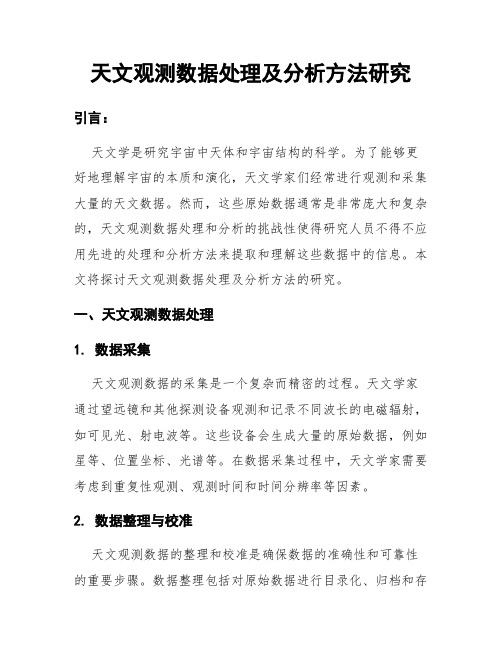
天文观测数据处理及分析方法研究引言:天文学是研究宇宙中天体和宇宙结构的科学。
为了能够更好地理解宇宙的本质和演化,天文学家们经常进行观测和采集大量的天文数据。
然而,这些原始数据通常是非常庞大和复杂的,天文观测数据处理和分析的挑战性使得研究人员不得不应用先进的处理和分析方法来提取和理解这些数据中的信息。
本文将探讨天文观测数据处理及分析方法的研究。
一、天文观测数据处理1. 数据采集天文观测数据的采集是一个复杂而精密的过程。
天文学家通过望远镜和其他探测设备观测和记录不同波长的电磁辐射,如可见光、射电波等。
这些设备会生成大量的原始数据,例如星等、位置坐标、光谱等。
在数据采集过程中,天文学家需要考虑到重复性观测、观测时间和时间分辨率等因素。
2. 数据整理与校准天文观测数据的整理和校准是确保数据的准确性和可靠性的重要步骤。
数据整理包括对原始数据进行目录化、归档和存储,以便后续的分析和研究。
数据校准则旨在消除观测仪器和环境等因素引入的误差,并使得不同观测数据之间具有可比性。
校准过程通常包括对仪器响应进行建模和估计,以及消除仪器漂移和大气透明度的影响。
此外,校准还可能涉及天体位置和光度的修正。
3. 数据降噪与处理天文观测数据通常受到各种源的噪声和干扰的影响,如大气湍流、电子回旋共振、射电外插法等。
因此,天文学家需要采取相应的降噪和数据处理方法来提高数据的信噪比和质量。
常见的降噪方法包括滤波、平滑、激发和噪声预测等。
此外,为了更好地提取有用的信息,可以利用数学和统计学方法对数据进行重采样、插值或平滑处理。
二、天文观测数据分析方法1. 数据可视化与探索数据可视化是天文观测数据分析的关键步骤之一。
通过可视化,研究人员可以更直观地理解和解释数据,发现其中的模式和规律。
可视化技术可以采用二维或三维图形表达数据,例如散点图、柱状图、等高线图、星系团图等。
此外,虚拟现实、增强现实和交互式可视化技术也被应用于天文数据的探索和分析。
天文学实验中的观测数据处理和结果分析方法

天文学实验中的观测数据处理和结果分析方法天文学是一门研究宇宙及其内部现象的科学,它通过观测和分析天体的运动、光谱、辐射等数据来揭示宇宙的奥秘。
观测数据处理和结果分析是天文学研究中不可或缺的环节,它们能够帮助天文学家从海量的数据中提取有用的信息,进而推动对宇宙的认识。
一、数据处理天文学实验中的观测数据处理是一个复杂而关键的过程。
首先,观测数据需要进行预处理,包括校准和去除噪声。
校准是指将观测数据与已知的标准数据进行比较,以确定观测仪器的误差和系统偏差,并进行修正。
噪声是指由于环境、仪器等原因引入的随机误差,需要通过滤波等方法进行去除。
其次,观测数据需要进行数据降维和数据压缩。
数据降维是指将高维度的观测数据转化为低维度的数据,以方便后续的分析和处理。
常用的方法包括主成分分析和小波变换等。
数据压缩是指通过压缩算法减少数据的存储空间和传输带宽,以提高数据处理的效率。
最后,观测数据还需要进行数据挖掘和数据可视化。
数据挖掘是指从大量的观测数据中发现隐藏的模式和规律,以帮助天文学家做出更准确的推断和预测。
数据可视化是指将观测数据以图表、图像等形式展示出来,以便于天文学家对数据进行直观的理解和分析。
二、结果分析天文学实验中的结果分析是根据观测数据得出结论和发现的过程。
首先,天文学家需要对观测数据进行统计分析,包括计算平均值、方差、相关系数等。
统计分析能够帮助天文学家了解观测数据的分布情况和相关性,从而为后续的分析提供基础。
其次,天文学家需要进行模型拟合和参数估计。
模型拟合是指将观测数据与理论模型进行比较,以确定最佳的模型参数。
参数估计是指根据观测数据估计未知参数的数值。
模型拟合和参数估计能够帮助天文学家验证理论模型的准确性,并推断宇宙中的物理过程和参数。
最后,天文学家需要进行数据解读和结果验证。
数据解读是指根据观测数据得出结论和发现,从而回答科学问题。
结果验证是指通过实验重复和数据对比等方法验证结论的正确性和可靠性。
天文学实验中的观测记录和数据分析技巧

天文学实验中的观测记录和数据分析技巧在天文学领域,观测记录和数据分析是非常重要的环节。
通过观测记录和数据分析,天文学家可以获得有关天体和宇宙的重要信息。
本文将介绍天文学实验中的观测记录和数据分析技巧。
一、观测记录观测记录是天文学实验中的第一步。
在进行观测之前,天文学家需要准备好观测仪器,并记录下观测的时间、地点、天气等相关信息。
观测记录的准确性对后续的数据分析非常重要。
观测记录中的时间信息可以帮助天文学家确定天体的位置和运动轨迹。
地点信息可以帮助天文学家了解观测的环境条件,例如大气湍流、光污染等对观测结果的影响。
天气信息可以帮助天文学家判断观测是否受到云层、降水等天气因素的干扰。
除了基本的观测信息外,观测记录还应包括观测仪器的参数设置、观测目标的特征描述等。
这些详细的观测记录可以帮助天文学家更好地理解观测结果,并进行数据分析。
二、数据采集与处理观测完成后,天文学家需要对采集到的数据进行处理。
数据处理的目的是去除干扰因素,提取有用的信息。
首先,天文学家需要对原始数据进行校正。
校正的目的是消除观测仪器的误差、大气湍流的影响等。
校正方法包括背景校正、平均校正等。
通过校正,天文学家可以得到更准确的数据。
接下来,天文学家需要对数据进行滤波处理。
滤波的目的是去除噪声、平滑数据等。
常用的滤波方法有均值滤波、中值滤波等。
滤波后的数据更易于分析和解释。
在数据处理过程中,天文学家还需要注意数据的可靠性和准确性。
数据的可靠性可以通过重复观测和对比分析来验证。
数据的准确性可以通过与已知的标准数据进行比对来评估。
三、数据分析数据分析是天文学实验中的关键环节。
通过数据分析,天文学家可以推断出天体和宇宙的性质和规律。
数据分析的方法有很多种,包括统计分析、谱线分析、图像处理等。
在进行数据分析之前,天文学家需要对数据进行预处理,例如去除异常值、归一化等。
统计分析是天文学中常用的方法之一。
通过统计分析,天文学家可以获得天体的平均值、标准差、相关系数等信息。
天文学中的时序分析方法研究
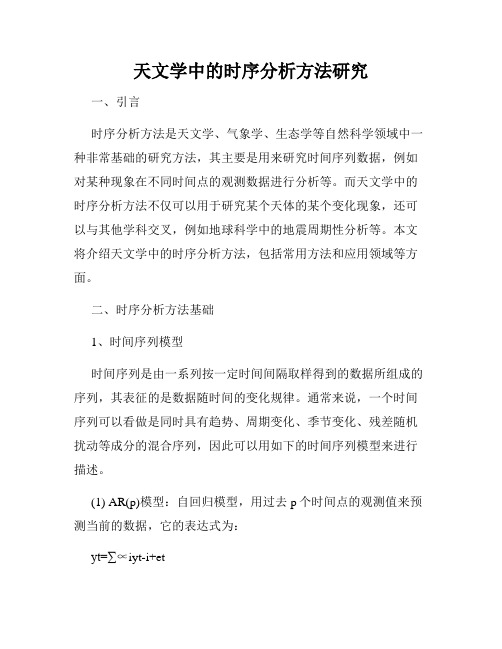
天文学中的时序分析方法研究一、引言时序分析方法是天文学、气象学、生态学等自然科学领域中一种非常基础的研究方法,其主要是用来研究时间序列数据,例如对某种现象在不同时间点的观测数据进行分析等。
而天文学中的时序分析方法不仅可以用于研究某个天体的某个变化现象,还可以与其他学科交叉,例如地球科学中的地震周期性分析等。
本文将介绍天文学中的时序分析方法,包括常用方法和应用领域等方面。
二、时序分析方法基础1、时间序列模型时间序列是由一系列按一定时间间隔取样得到的数据所组成的序列,其表征的是数据随时间的变化规律。
通常来说,一个时间序列可以看做是同时具有趋势、周期变化、季节变化、残差随机扰动等成分的混合序列,因此可以用如下的时间序列模型来进行描述。
(1) AR(p)模型:自回归模型,用过去p个时间点的观测值来预测当前的数据,它的表达式为:yt=∑∝iyt-i+et其中,et是一个白噪声随机变量,∝i为系数。
(2) MA(q)模型:移动平均模型,引入前q个白噪声误差来生成当前的数据,正式表达为:yt=∑βjεt-j+et其中,et是一个其方差为常数的白噪声随机变量,βj为系数。
(3) ARMA(p, q)模型:自回归移动平均模型,将上述两种模型结合起来进行描述。
因为时间序列由多种成分混合而成,因此ARMA模型是一种很常见的模型。
2、傅里叶分析傅里叶变换可将信号分解成不同频率的正弦波分量,用于研究周期性变化。
在天文学中,傅里叶分析常用于研究天体的周期性变化规律。
对于不同的周期性变化,可以通过傅里叶变换将其分解成不同的基波。
在天文学中,常用快速傅里叶变换(FFT)算法来进行信号分解。
3、小波分析小波分析是一种基于波形分析的时序分析方法,它可以在时间和频域上同时进行分析。
在时间域上,小波分析能够定位和描述瞬时时序性的变化,而在频率上,则能够描述随时间而变化的频率。
在天文学中,小波分析常用于研究非平稳时间序列数据的变化规律。
天文光度数据的时序分析方法研究

天文光度数据的时序分析方法研究天文学研究自古以来就是人类对宇宙的好奇心驱使下不断进行的努力。
而光度数据则是天文学研究中的重要一环,通过对恒星、行星、星云等天体的光度数据进行分析,不仅可以揭示宇宙的奥秘,还可以帮助天文学家推断出天体的性质、演化和变化规律。
本文将探讨天文光度数据的时序分析方法,以期提供一种可行的思路和方法。
第一部分:光度数据简介光度是表示物体辐射功率的物理量,是指物体单位时间内从单位面积内通过的光通量。
对于天体,其光度可以反映出其亮度和能量释放情况。
通过测量恒星、行星等天体的光度变化,天文学家可以推断出天体的物理性质、温度、大小等重要信息。
第二部分:时序分析方法2.1 傅里叶变换傅里叶变换是一种重要的时序分析方法,可以将复杂的时域信号转换为频域信号,进而揭示出信号的周期性、频率成分及其强度。
对于天文光度数据,可以通过傅里叶变换找到重要的周期性信号,例如恒星的光变周期。
2.2 小波变换小波变换是一种时频分析方法,可以同时观察到时域和频域的信息。
相比于傅里叶变换,小波变换可以更好地适应信号的非平稳性特点。
在天文光度数据分析中,小波变换可以提供更详细的频率分布信息,帮助发现那些难以被傅里叶变换发现的短时尺度的信号。
2.3 平滑法平滑法是一种常用的时序分析方法,通过对光度数据进行滤波处理,消除噪声和异常值,使得数据变得更加平滑和易于分析。
常见的平滑法包括均值平滑法、中位数平滑法和高斯滤波法。
在天文光度数据的分析中,平滑法可以帮助减少数据的噪声对结果的影响,突出数据的趋势和周期性信号。
第三部分:案例分析以一个具体的案例来说明天文光度数据的时序分析方法的应用。
以恒星的光度变化为例,我们收集到一组关于某颗恒星的光度数据,并进行以下分析:3.1 傅里叶变换利用傅里叶变换方法,我们发现恒星的光度数据存在明显的周期性信号,表明恒星具有一定的光变周期。
通过对频谱图的分析,我们可以估计出光变周期大致在30至35天之间,为进一步探索周期变化特征,我们可以通过更细致的分析找到更准确的周期值。
天文学中的大数据分析技术研究

天文学中的大数据分析技术研究近年来,随着科技的进步和数据的不断积累,天文学中的大数据分析技术成为该领域的重要研究方向。
天文学是研究宇宙现象的学科,通过对观测数据的分析,可以进一步理解宇宙的本质,探索宇宙的奥妙之处。
一、大数据在天文学中的应用天文学研究的对象是星系、恒星、行星、宇宙射线等宇宙现象,由于天体的数量巨大、观测数据的复杂性和多样性,因此天文学成为大数据的源头之一。
目前,国内外天文学家们正在开展一系列大数据的观测和分析工作。
在天文学的观测中,由于天象的多变性、信号的微弱性以及恶劣观测环境的影响,导致产生的数据规模非常大。
同时,为了研究天文学问题,需要多个望远镜同时观测同一个天体,这就加大了数据的规模和复杂度。
二、大数据的分析方法大数据在天文学中的分析方法更加多样化。
从观测的角度上来说,根据需要进行不同的数据处理和分析,比如数据预处理、数据压缩、数据挖掘等。
从分析的角度上来说,可以归纳为两大类:(一)图像分析。
天文学中的图像数据具有很多复杂的特征,如噪声、天体光学属性、旋转和不同角度的观测。
传统的分析方法主要依赖于人类的视觉判断,但这种手工方式容易出错并且需要投入巨大的人力物力。
因此,天文学家们采用了各种计算机视觉算法,以识别和提取图像特征,比如特征点检测、边缘检测、区域生长算法和主成分分析等。
(二)机器学习。
另一方面,机器学习是目前在天文学中广泛应用的技术之一,主要包括神经网络、支持向量机等。
天文学家将这些算法应用于分析天文数据,以发现其中的多种关系和规律。
尽管需要在算法和技术的选择方面做出权衡,但目前的分析技术已经可以处理大规模的天文数据,以便进行为期数年的研究工作。
不断发展的技术和工具,已经极大地促进了天文学在大数据方面的研究和分析。
三、大数据分析在天文学中的应用实例大数据分析在天文学中产生了多个实例。
例如:ESO公布了Hubble桌面计划的一线研究成果,利用针对大透镜ANNA和斑马P435分别获得了质量约为5,000和50,000亿太阳质量的生动模拟。
用天文测量简历精确计算太阳位置的方法
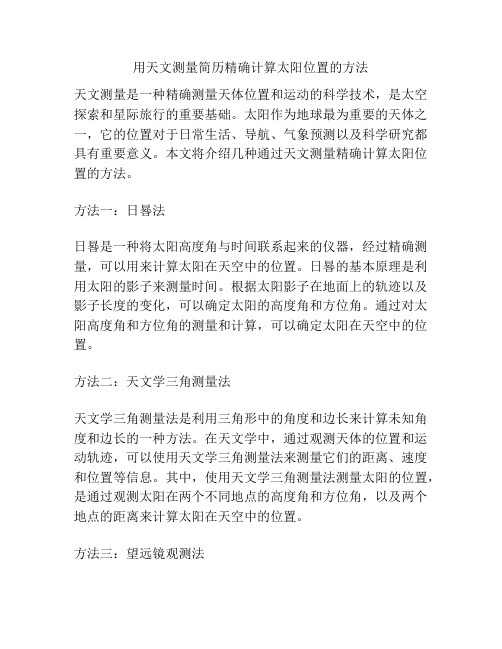
用天文测量简历精确计算太阳位置的方法天文测量是一种精确测量天体位置和运动的科学技术,是太空探索和星际旅行的重要基础。
太阳作为地球最为重要的天体之一,它的位置对于日常生活、导航、气象预测以及科学研究都具有重要意义。
本文将介绍几种通过天文测量精确计算太阳位置的方法。
方法一:日晷法日晷是一种将太阳高度角与时间联系起来的仪器,经过精确测量,可以用来计算太阳在天空中的位置。
日晷的基本原理是利用太阳的影子来测量时间。
根据太阳影子在地面上的轨迹以及影子长度的变化,可以确定太阳的高度角和方位角。
通过对太阳高度角和方位角的测量和计算,可以确定太阳在天空中的位置。
方法二:天文学三角测量法天文学三角测量法是利用三角形中的角度和边长来计算未知角度和边长的一种方法。
在天文学中,通过观测天体的位置和运动轨迹,可以使用天文学三角测量法来测量它们的距离、速度和位置等信息。
其中,使用天文学三角测量法测量太阳的位置,是通过观测太阳在两个不同地点的高度角和方位角,以及两个地点的距离来计算太阳在天空中的位置。
方法三:望远镜观测法望远镜观测法是利用望远镜来观察太阳,通过测量太阳的大小和位置,来计算太阳在天空中的位置。
望远镜可以提供更加精确和详细的太阳图像,同时也可以通过望远镜的调节和校正来消除大气的影响,进一步提高观测精度。
方法四:地球磁场观测法地球磁场观测法是利用地球磁场的变化来精确测量太阳位置的一种方法。
太阳活动会影响地球磁场,因此,通过观测地球磁场的变化,可以获得太阳活动的信息。
通过计算地球磁场的变化,以及太阳、地球和观测点的位置,可以计算出太阳在天空中的位置。
以上四种方法是通过天文测量精确计算太阳位置的常用方法。
不同的方法适用于不同的场景和精度要求。
无论使用哪种方法,天文测量的基础仍然是精确测量和计算。
因此,天文学家和测量技术人员需要具备精确测量和计算的技能,以及对天文学的深刻理解和热爱。
相关数据是指对研究对象进行的各种观测、测量、实验等数据,是进行科学研究和分析的基础。
天文观测技术和数据分析

天文观测技术和数据分析天文学是研究太阳系、恒星、星系、星系团以及宇宙本身的科学,也是大家最熟悉的一个学科。
现在,天文学已经成为了一门交叉学科,需要很强的物理学、数学和计算机科学知识作为支撑。
天文学发展的核心驱动,是天文观测技术和数据分析。
一、天文观测技术天文观测技术主要是为了获取宇宙中的信息,例如恒星的温度、亮度、组成以及运动等与地球相关的量。
在过去,天文观测只是观测天空,但随着时间的推移,观测的天空覆盖的面积越来越大,现在的天文观测已经可以覆盖整个宇宙。
天文观测技术一直都在进步和改进,这种技术的发展可以帮助天文学家研究宇宙中更多的细节。
目前,天文观测技术已经达到了前所未有的高度。
天文学家现在可以利用卫星、航天器、不同类型的望远镜及其他先进技术来观测天空。
1.卫星人类通过人造卫星,可以在太空中观测宇宙。
由于大气层的存在,地面观测会受到很多影响,但是人造卫星却可以避免这些影响。
这种观测方式可以搜集关于宇宙的很多信息,但它需要比地面观测更大的投入。
2.飞行器飞行器以各种方式运输并操作特殊设备以观测宇宙。
望远镜、探测器等设备都可以通过飞行器被送往宇宙、在特定地点进行观测。
由于在宇宙中不存在大气层等干扰因素,天空中的许多星系、恒星信息都可以通过飞行器获得。
3.望远镜在地球上,望远镜是观测天象的核心设备。
其中,光学望远镜是最早发展的望远镜,其基本式样已发展了数百年。
现在望远镜已经成为一个复杂的系统,包括了一些特殊的检测设备,如光电倍增管和谱仪等。
4.射电望远镜射电望远镜可以从较远的距离接收到无线电信号,在用射电天文望远镜进行观测时,一个目标星系会将射电波传送到地球上,这些波被捕获后,通过放大、消除杂音等处理后就可以被科学家分析。
二、数据分析天文学中的数据分析通常是通过计算机程序来完成的,这些程序主要用于分析观测到的数据。
利用这些程序,天文学家可以处理算法、实现数据可视化、以及进行统计分析。
1. 数据存储天文学家会在一个特定的数据中心存储所有的数据,这些数据中心的数据包括了天空照片、光谱图、历史数据等。
天文学行业中的天体观测数据分析技术的使用方法

天文学行业中的天体观测数据分析技术的使用方法天文学是一门研究宇宙中天体及其运动规律的学科,通过观测和分析天体数据,可以洞察宇宙的奥秘。
天体观测数据的分析技术在天文学研究中起着至关重要的作用。
本文将介绍天文学行业中常用的天体观测数据分析技术的使用方法。
一、天体观测数据的收集天文学家通过望远镜等设备进行天体观测,观测数据包括天体的位置、亮度、频谱等信息。
这些数据以表格或图像的形式记录下来,作为进一步分析的基础。
二、天体数据的预处理在进行数据分析之前,需要对观测数据进行预处理,主要包括数据清洗、去噪、校准等步骤。
数据清洗是为了去除异常值、缺失值和重复值等对数据分析的影响,确保数据的准确性。
去噪是为了剔除观测数据中的随机干扰,提高数据的信噪比。
校准是为了消除仪器误差和环境因素对数据的影响,使得观测数据更加精确。
三、天体数据的可视化分析天体观测数据通常是多维的,利用可视化分析可以更好地理解数据的特征和规律。
常用的可视化工具包括散点图、柱状图、折线图、热力图等,利用这些图表可以直观地展示数据的分布情况、变化趋势和相互关系。
四、天体数据的统计分析统计分析是天体观测数据分析的重要手段,可以从数据中挖掘有意义的信息。
常用的统计分析方法包括概率分布拟合、相关性分析、回归分析等。
通过这些方法,可以揭示天体的特征、规律和相互关系,为天文学研究提供重要的参考。
五、天体数据的模型建立与拟合为了更准确地描述和预测天体的运动和属性,需要建立合适的模型。
在天文学中,常用的模型包括开普勒模型、恒星演化模型、宇宙膨胀模型等。
根据观测数据,通过拟合方法可以确定模型的参数,使模型与观测数据尽可能吻合。
这样可以提取隐藏在数据背后的物理规律,并用于研究未知的天体现象。
六、天体数据的模拟与仿真除了对观测数据进行分析,天文学家还可以通过模拟和仿真来研究天体的性质和演化过程。
通过建立数学模型和物理模型,结合计算机模拟方法,可以模拟天体的运动、星系的形成、宇宙的演化等过程。
天文学数据处理中的大数据应用技巧
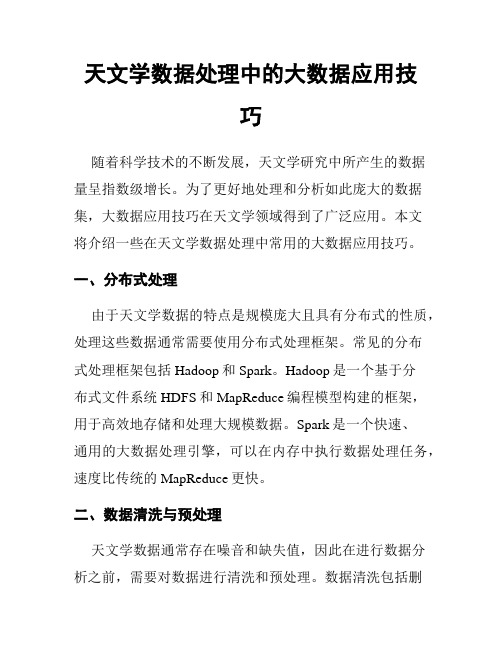
天文学数据处理中的大数据应用技巧随着科学技术的不断发展,天文学研究中所产生的数据量呈指数级增长。
为了更好地处理和分析如此庞大的数据集,大数据应用技巧在天文学领域得到了广泛应用。
本文将介绍一些在天文学数据处理中常用的大数据应用技巧。
一、分布式处理由于天文学数据的特点是规模庞大且具有分布式的性质,处理这些数据通常需要使用分布式处理框架。
常见的分布式处理框架包括Hadoop和Spark。
Hadoop是一个基于分布式文件系统HDFS和MapReduce编程模型构建的框架,用于高效地存储和处理大规模数据。
Spark是一个快速、通用的大数据处理引擎,可以在内存中执行数据处理任务,速度比传统的MapReduce更快。
二、数据清洗与预处理天文学数据通常存在噪音和缺失值,因此在进行数据分析之前,需要对数据进行清洗和预处理。
数据清洗包括删除重复数据、处理异常值和纠正错误数据等操作。
对于缺失值,可以使用插值算法进行填充。
此外,还可以应用特征工程技术提取有用的特征,以便更好地描述和分析天文学现象。
三、数据可视化数据可视化是将大数据转化为可视化图像的过程,它可以帮助研究人员更好地理解和分析天文学数据。
在进行数据可视化时,可以使用一些常用的图形表示方法,如散点图、柱状图、折线图等。
此外,还可以利用地理信息系统(GIS)技术将天文学数据与空间地理位置进行关联,以便更好地分析天文学现象的空间分布。
四、机器学习算法机器学习算法是在大数据分析中常用的工具之一,它可以从数据中学习规律并进行预测。
在天文学数据分析中,机器学习算法可以用于识别天文学目标、分类不同类型的天体、预测天文学现象等。
常见的机器学习算法包括决策树、支持向量机、神经网络等。
使用这些算法可以帮助研究人员从大量数据中发现规律,推测物理过程和天文学现象。
五、数据存储与管理在处理大数据时,数据的存储和管理是一个重要的问题。
为了更好地管理和查询天文学数据,可以使用数据库管理系统(DBMS)来存储和管理数据。
天文学知识:天文学家如何确定行星的质量、密度和组成

天文学知识:天文学家如何确定行星的质量、密度和组成天文学家通过观测和分析星体的物理特征,特别是其重力和轨道运动,确定行星的质量、密度和组成。
这些数据对于了解行星的物理和化学特性以及其形成和演化历史非常重要。
第一种确定行星质量的方法是观测行星对其母星的引力效应。
行星质量越大,其对母星的引力越大,因此可以通过测量母星在行星周围的运动轨迹来确定行星的重力。
当然,在这种方法下,只有行星公转角度很小,星体运动轨迹被明显影响时,可获得行星的质量数据。
这也是当前科学家所采用的最常用方法。
第二种方法是使用行星的射线屈曲效应。
当光束穿过重力强大的星体时,其会偏离原来的路径。
这种现象称为光线屈曲。
对于行星来说,其质量越大,光线屈能力越强。
因此,天文学家可以通过测量星光被行星局部挡住的程度,间接推断其质量。
这是另外一个观测行星重量的方法,同时它也能提供信息来确定其密度和组成。
因为行星质量和半径的比例给出一个计算平均密度的指标,而通过光的屈曲情况,我们也能推断有关行星的化学特征。
第三种方法是利用行星的轨道动力学。
在公转中,行星的轨道的形状、速度和倾斜角等参数都可以提供有关行星的质量信息。
这种方法可以被用于行星系外观测,天文学家可以根据恒星的光变特征和行星的公转周期、轨道形状等参数计算出其质量。
确定行星的密度和组成也需要结合多种数据进行分析。
行星的密度分布与其内部物态有关,同时也与其物质组成有关。
例如,如果行星由相对较重的岩石和金属构成,其密度可能比较高;如果行星由比较轻的气体和冰制成,其密度可能比较低。
行星的组成还可以通过分析其大气层中的化学成分、表面形态以及行星周围行星环和行星卫星的特征来推断,这些数据可以揭示行星的化学和地质特性。
总而言之,天文学家使用许多观测手段和分析技术来确定行星的质量、密度和组成。
这些数据有助于我们研究行星的物理学、地质学和化学特性,它们也有助于我们了解更多有关行星形成和演化的历史和过程。
- 1、下载文档前请自行甄别文档内容的完整性,平台不提供额外的编辑、内容补充、找答案等附加服务。
- 2、"仅部分预览"的文档,不可在线预览部分如存在完整性等问题,可反馈申请退款(可完整预览的文档不适用该条件!)。
- 3、如文档侵犯您的权益,请联系客服反馈,我们会尽快为您处理(人工客服工作时间:9:00-18:30)。
A = np.c_[np.exp(-xi)[:,np.newaxis],xi[:,np.newaxis]] c,resid,rank,sigma = splin.lstsq(A,zi) print c,resid,rank,sigma
天文数据分析方法和计算
plt.show()
Maximum Likelihood Estimation (MLE)
天文数据分析方法和计算
最大似然估计
• 一致收敛 • 渐近于正态分布:有极值
天文数据分析方法和计算
等精度高斯分布
天文数据分析方法和计算
非等精度高斯分布
天文数据分析方法和计算
上下限分布
# use RBF rbf = Rbf(x, y, z, epsilon=2) ZI = rbf(XI, YI)
# plot the result n = plt.Normalize(-2., 2.) plt.subplot(1, 1, 1) plt.pcolor(XI, YI, ZI, cmap=cm.jet) plt.scatter(x, y, 100, z, cmap=cm.jet) plt.title('RBF interpolation - multiquadrics') plt.xlim(-2, 2) plt.ylim(-2, 2) plt.colorbar()
plt.show()
天文数据分析方法和计算
数据拟合
天文数据分析方法和计算
• O=T+e
拟合模型
天文数据分析方法和计算
最小二乘法
天文数据分析方法和计算
import numpy as np import scipy.linalg as splin import matplotlib.pyplot as plt
from scipy.optimize import leastsq plsq = leastsq(residuals, p0, args=(y_meas, x)) print plsq[0] # [ 10.9437 33.3605 0.5834]
print array([A, k, theta]) # [ 10. 33.3333 0.5236]
非线性拟合
• 拟合系数有非线性函数关系
天文数据分析方法和计算
from numpy import x = arange(0,6e-2,6e-2/30) A,k,theta = 10, 1.0/3e-2, pi/6 y_true = A*sin(2*pi*k*x+theta) y_meas = y_true + 2*random.randn(len(x))
xi2 = np.r_[0.1:1.0:100j] yi2 = c[0]*np.exp(-xi2) + c[1]*xi2
plt.plot(xi,zi,'x',xi2,yi2) plt.axis([0,1.1,3.0,5.5]) plt.xlabel('$x_i$') plt.title('Data fitting with linalg天.l文st数sq据')分析方法和计算 plt.show()
天文数据分析方法和计算
天文数据分析方法和计算
数据分析方法
天文数据分析方法和计算
累积概率分布
天文数据分析方法和计算来自任意分布的随机数天文数据分析方法和计算
常用概率分布
天文数据分析方法和计算
数据插值
天文数据分析方法和计算
内插和外推
天文数据分析方法和计算
插值(scipy.interpolate)
import matplotlib.pyplot as plt
plt.plot(x,peval(x,plsq[0]),x,y_meas,'o',x,y_true)
plt.title('Least-squares fit to noisy data')
plt.legend(['Fit', 'Noisy', 'True'])
• 线性1d插值 (interp1d) • 1d样条插值 (interpolate.splXXX) • 2d样条插值 (bisplrep) • RBF(radial basis function)插值/平滑
天文数据分析方法和计算
import numpy as np from scipy.interpolate import Rbf import matplotlib.pyplot as plt from matplotlib import cm
天文数据分析方法和计算
求极值scipy.optimize
A collection of general-purpose optimization routines. fmin -- Nelder-Mead Simplex algorithm (uses only function calls) fmin_powell -- Powell's (modified) level set method (uses only function calls) fmin_cg -- Non-linear (Polak-Ribiere) conjugate gradient algorithm (can use function and gradient). fmin_bfgs -- Quasi-Newton method (Broydon-Fletcher-Goldfarb-Shanno); (can use function and gradient) fmin_ncg -- Line-search Newton Conjugate Gradient (can use function, gradient and Hessian). leastsq -- Minimize the sum of squares of M equations in N unknowns given a starting estimate.
def residuals(p, y, x): A,k,theta = p err = y-A*sin(2*pi*k*x+theta) return err
def peval(x, p): return p[0]*sin(2*pi*p[1]*x+p[2])
p0 = [8, 1/2.3e-2, pi/3] print array(p0) # [ 8. 43.4783 1.0472]
# 2-d tests - setup scattered data x = np.random.rand(100)*4.0-2.0 y = np.random.rand(100)*4.0-2.0 z = x*np.exp(-x**2-y**2) ti = np.linspace(-2.0, 2.0, 100) XI, YI = np.meshgrid(ti, ti)
